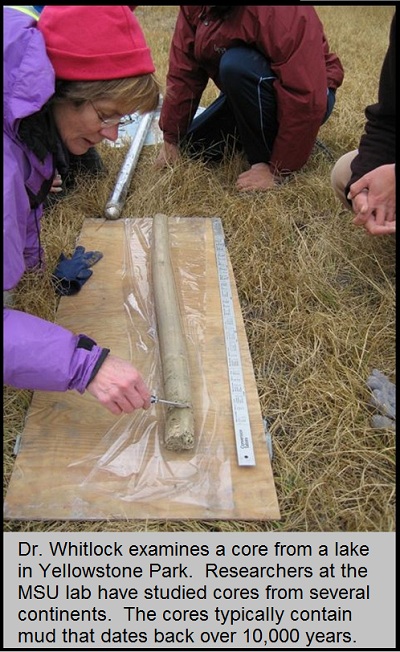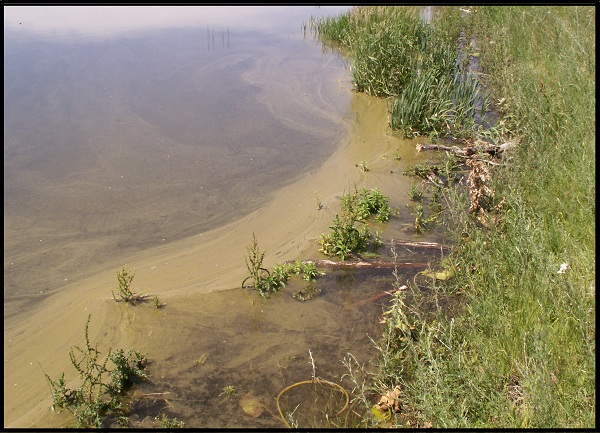 MSU Paleoecologists Study Ancient Lake Mud MSU Paleoecologists Study Ancient Lake Mud
Paleo refers to ancient, and ecology is the study of interactions between organisms and their environment. The goal of paleoecology is to learn about pre-historic ecosystems in a specific region, using clues found in nature. It is related to a broader science called paleoclimatology, which strives to understand past climates and factors that influence them. Research in both areas has increased in recent decades because we've recognized the importance of understanding climate change and how it affects ecosystems. Knowledge gained from this research will help us understand climate change and be more informed as we plan for the future.
One person's mud is another person's treasure . . .
There are several places to find clues about past climates and ecosystems, and many of them involve core sampling, including glacial ice, sea-floor sediment, tree-rings, and coral reefs. Research groups at various universities and institutions throughout the world specialize in the study of each of type of core. At the Montana State University Paleoecology Lab, the focus is on lake-sediment cores that contain mud deposited since the end of the last ice age, over 10,000 years ago. In fact, under the direction of Dr. Cathy Whitlock, the MSU research group is among the world leaders in this area. Whitlock and other scientists at the lab have studied cores from several continents. Since most lakes formed since the last glacial maximum (about 20,000 years ago) lake-sediment research is limited to this part of Earth's history. But, understanding this period is especially important because it witnessed the rise of civilizations, the agricultural revolution, the industrial revolution, and some interesting climate changes.
Why lake mud? . . .
Lakes are basins (low places) where a variety of materials are deposited, and may sit undisturbed for thousands of years. Some of these materials provide clues that help researchers figure out what the ecosystem and climate were like thousands of years ago. For example, cores from the depths of small lake between Missoula and Great Falls represent the top 8.85 meters of sediment, which has been deposited over the past 12,500 years.
Besides clay that was transported as wind-blown dust, organic materials, and complex geochemical clues, the mud contains two fairly straight-forward types of evidence related to past climates. Pollen from plants that lived in the area is abundant in the mud can be identified and counted to determine which plant species lived in the area and which ones were most abundant. Knowing this is crucial to understanding the climatic conditions that existed when those sediments settled to the bottom of the lake. Another clue, fragments of charcoal that are embedded in the layers of mud, provides data about the timing and extent of ancient forest fires in the ecosystem. As recent large forest fires in the West have shown, climate, vegetation, and fire are closely related, making ancient charcoal studies an important part of lake-sediment research. CLICK HERE to read more about fire research (The Billings Gazette).
How do they know how old? . . .
It makes no sense to do charcoal and pollen counts unless you can determine the age of the mud at specific depths . . . and there are a couple ways to do this. For one, deposits of tephra (especially ash) from specific volcanoes serve as general markers for dating. Undisturbed lakes in Montana often include a layer of ash from the eruption of Mt. Mazama (Crater Lake) in Oregon ~7,600 years ago, as well as a layer from Glacier Peak in Washington, which erupted ~11,000 years ago. Another, more important way to date the layers, is to use radiocarbon dating (Carbon-14 dating). When larger pieces (at least 1 g.) of charcoal or seeds, etc. are found in mud, they can be sent to labs that specialize in determining their age. Once dates are established for certain layers, researchers can estimate the age of other layers. A small percentage of lake sediments are varved;, i.e. they have distinct layers that formed every year, much like tree-rings. If a core has varves, its simply a matter of counting back in time . . . one layer for each year.
 The fun part . . . The fun part . . .
One nice thing about research in any area of Earth Science is that it usually involves a field trip, often to a location that has not been too disturbed by human activity. Lake-sediment cores are obtained by pushing a coring device, which consists of a long metal cylinder, several meters into the mud. Coring is done in the deeper part of the lake where the sediment hasn't been disturbed by waves and animals. The process can be accomplished from a boat, but often it is done during the winter when the lake is frozen over. CLICK HERE to see a photo. Thick ice provides a strong platform to stand on as the device is pushed the into the mud and then pulled out. Once retrieved, the cores are kept in a refrigerated storage room in the same building as the Paleoecology Lab at MSU. Researchers make many trips to "cold storage" during the span of their project.
This photo was taken at a small lake between Great Falls and Missoula in July of 2011. It shows countless microscopic pollen grains that were recently released by plants in the area, including sage brush, ponderosa pine, and many others. Eventually many of the grains will settle to the bottom of the lake and be embedded in the mud that is deposited in 2011. If there are fires in the area, charcoal will also be deposited. This process has been going on for over 12,000 years at this lake, creating a valuable archive for paleoecologists. CLICK HERE to watch a short video about pine pollen (2:23).
Term: proxy evidence
|







